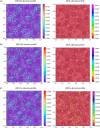Adsorption and Diffusion of CH4, N2, and Their Mixture in MIL-101(Cr): A Molecular Simulation Study
- PMID: 39691474
- PMCID: PMC11647892
- DOI: 10.1021/acs.jced.4c00233
Adsorption and Diffusion of CH4, N2, and Their Mixture in MIL-101(Cr): A Molecular Simulation Study
Abstract
A comprehensive quantitative grasp of methane (CH4), nitrogen (N2), and their mixture's adsorption and diffusion in MIL-101(Cr) is crucial for wide and important applications, e.g., natural gas upgrading and coal-mine methane capturing. Previous studies often overlook the impact of gas molecular configuration and MIL-101 topology structure on adsorption, lacking quantitative assessment of primary and secondary adsorption sites. Additionally, understanding gas mixture adsorption mechanisms remains a research gap. To bridge this gap and to provide new knowledge, we utilized Monte Carlo and molecular dynamics simulations for computing essential MIL-101 properties, encompassing adsorption isotherms, density profiles, self-diffusion coefficients, radial distribution function (RDF), and CH4/N2 selectivity. Several novel and distinctive findings are revealed by the atomic-level analysis, including (1) the significance of C=C double bond of the benzene ring within MIL-101 for CH4 and N2 adsorption, with Cr and O atoms also exerting notable effects. (2) Density distribution analysis reveals CH4's preference for large and medium cages, while N2 is evenly distributed along pentagonal and triangular window edges and small tetrahedral cages. (3) Calculations of self-diffusion and diffusion activation energies suggest N2's higher mobility within MIL-101 compared to CH4. (4) In the binary mixture, the existence of CH4 can decrease the diffusion coefficient of N2. In summary, this investigation provides valuable microscopic insights into the adsorption and diffusion phenomena occurring in MIL-101, thereby contributing to a comprehensive understanding of its potential for applications, e.g., natural gas upgrading and selective capture of coal-mine methane.
© 2024 The Authors. Published by American Chemical Society.
Conflict of interest statement
The authors declare no competing financial interest.
Figures














References
-
- Xu H. Facilitating full and effective implementation of the Paris Agreement for carbon neutrality vision. Carbon Neutrality 2022, 1 (1), 3.10.1007/s43979-022-00014-8. - DOI
-
- Gielen D.; Kram T.. The Role of Non-CO2 Greenhouse Gases in Meeting Kyoto Targets 1. Climate Change and Economic Modelling: Background Analysis for the Kyoto Protocol, Paris, France, Sept 17–18, 1998.
-
- Ivanova S.; Vesnina A.; Fotina N.; Prosekov A. An Overview of Carbon Footprint of Coal Mining to Curtail Greenhouse Gas Emissions. Sustainability 2022, 14 (22), 15135.10.3390/su142215135. - DOI
-
- Wang X.; Zhou F.; Ling Y.; Xiao Y.; Ma B.; Ma X.; Yu S.; Liu H.; Wei K.; Kang J. Overview and Outlook on Utilization Technologies of Low-Concentration Coal Mine Methane. Energy Fuels 2021, 35 (19), 15398–15423. 10.1021/acs.energyfuels.1c02312. - DOI
LinkOut - more resources
Full Text Sources
Miscellaneous
